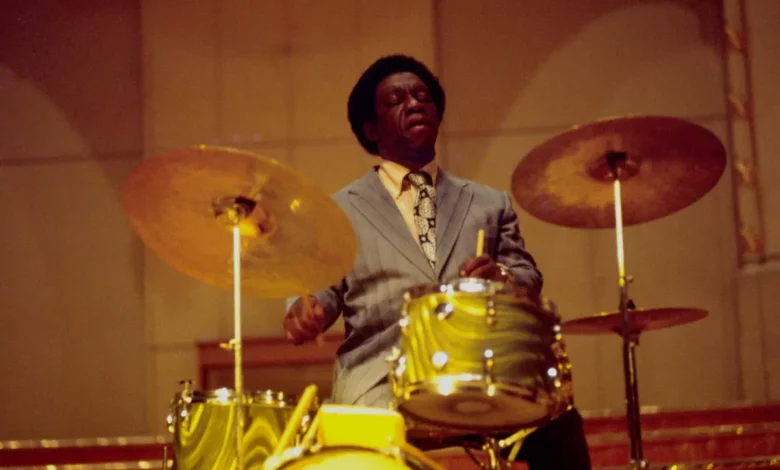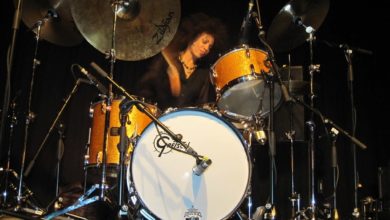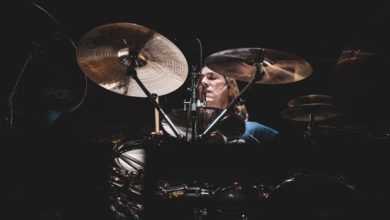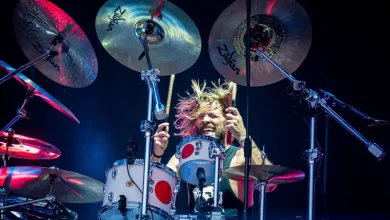
The 1950s were a sunny decade. The United States began recovering from WWII, and the economy was booming: The era was even coined “The Golden Age of Capitalism” and “The Golden Age of Television.” That sure is a lot of gold! Even more brilliant than that, the Civil Rights Movement began, and Rock and Roll was first introduced. Today, we will look at nine giants of rock, jazz, and blues percussion from the ’50s.
Chicago Blues to Rock
You’ll likely notice that many of these drummers are from Chicago. The Chicago Blues is a type of electric blues and one of the biggest “ancestor genres” of rock. So for the sake of this next chunk of text, it’s safe to use the terms ‘Chicago Blues’ and ‘early rock’ near-synonymously.
In this article, we will honor some of the most innovative drummers of this decade. Let’s go!
Frederick Bellow Jr.
First on the list is Frederick Bellow Jr. because everyone loves “Johnny B. Good!”
Frederick Bellow Jr. was an American drummer from Chicago, Illinois, and is credited with creating the rhythmic basis for the Chicago blues. His work with Chuck Berry resulted in the grooving and fiery “Johnny B. Goode,” which was first released in 1958 and ended up #2 in the charts. But Frederick Bellow’s work as a musician began long before this single. His musical background was originally in jazz. Bellow had played in the jazz band in high school and later polished his bop chops once he joined the army band.
But he later discovered that blue was becoming more popular than jazz was, so he changed his tune (literally!) and joined singer Little Walter and his band. Bellow also recorded with Bo Diddley, Willie Dixson, and many other famous musicians of the era. Bellow has been pictured with Gretch, Ludwig, and other kits — but seemed to be little loyal to any particular brand.
Listen to how even these running eights are in Johnny B. Goode, live from 1958.
Charles Connor
Next up is Charles Connor, a New Orleans, Louisiana, percussionist who pioneered an early rock beat. Connor played Little Richard, a rock and roll singer. (Notice how all the cool cat vocalists used the word “Little” in front of their names?! Not much has changed, after all…). Yet, despite his creating a quintessential rock beat, Charles Connor is relatively unknown!
The story behind his rock beat is quirky: It is rumored that Little Richard once asked for a rhythm that sounded like a train, and thus the groove was made. Many songs have been based on this train beat! Check out this example of his groove in “Long Tail Sally” here.
Little Richard and his band influenced many notable musicians, such as the English singer-songwriter David Bowie. In addition, Charles Connor played with the King of Soul (Sam Cooke) and James Brown. His ability to funkify songs with his hard-hitting eighth note pattern is purely iconic, and like Bo Diddley, his early rock pattern can be heard in many places today.
Gene Krupa
Gene Krupa was a creative jazz drummer from Chicago, Illinois. Though he’s on our 50’s drummer list, his percussion skills were popular from the 1930s and forward. Once Krupa joined clarinetist Benny Goodman and his band, he recorded the famous tune “Sing, Sing, Sing.” It’s rumored that Krupa was kicked out of Benny Goodman’s band because he stole too much of the spotlight — Oops!
Gene Krupa stakes the claim to many firsts, like being the first drummer to be recorded with a bass drum (Modern Drumming Magazine). His style was versatile, ranging from soft and gentle to energetic and heavy. Considering how groovy his rumbling tom pattern is from “Sing, Sing, Sing” (which you can listen to here), it’s no wonder he stole the show.
Buddy Rich
Buddy Rich (Aka The Drum Wonder) is one of the most well-known jazz drummers from the 50’s- And for a good reason! If you look at Rich’s biography, you’ll see that he can do it all, musically. Buddy Rich was a bandleader, conductor, songwriter, and, of course, a drummer.
Rich was raised in Brooklyn, New York, and began drumming before he was five. His style can be described as big band/ swing. Two of his most notable musical accomplishments are his band (The Buddy Rich Big Band) and his jazzy recordings of a medley of music from A West Side Story.
There is a bit of a ‘Buddy Rich’ Vs. Gene Krupa debate in the percussion world: Many jazzers argue about which percussionist was best. I’ll let you decide: watch Gene Krupa and Buddy Rich get into a friendly drum battle here.
Side note: I think it’s interesting that both Krupa and Rich play traditional grip — and many players from this era did. Traditional grip is also known as ‘jazz grip’ because of its prevalence in this genre.
Odie Payne
Oldie Payne was a Chicago Blues drummer from… Chicago! (You guessed it). And though he doesn’t top many drummer headlines anymore, Payne is another drummer who ended up working with the famous Chuck Berry.
Oldie Payne worked with several bands, including Elmore James and his Broomdusters. This drummer had success as both a session musician and group member alike. He is known for his frequent use of the double-shuffle pattern. A double shuffle (Aka the Chicago Shuffle) differs from a single shuffle because it requires two hands to make it go.
Check out one of the Broomduster’s albums, Blues After Hours, to hear some of his playings.
Max Roach
Max Roach was a multi-genre drummer and composer from North Carolina. He became a bebop legend that could play boiling grooves at up to 400 beats per minute. Though Roach gained much traction in the 1940s as the drummer at Upton House, he didn’t begin to access his musical prime until the 50s. From there, he became a famous percussive powerhouse well into the 70s.
Roach’s musical beginnings were in the genre of gospel. He was initially a singer who took up the drums in his late childhood. He later got into modern jazz and became one of the founders of bebop, a jazz subgenre known for its extremely fast chord changes and virtuosic soloing. His style was unique because he placed the beat on the ride cymbal more often than the bass drum, which percussionists typically did during this era of music.
Here’s a video of Max Roach’s quintet jamming in Paris.
Billy Gussak
Billy Gussak was a jazz/rock drummer and session musician. He is best known for recording “Rock Around the Clock” with Bill Haley and The Comets, which many still recognize today.
Gussak’s actual birthday and birthplace are unknown. He was born sometime in the 1920s, and by the time the mid-1930s hit, he was a famous musician… Which means he was gaining fame as a young teen.
As the drummer’s musicality progressed, he honed his sound and added more snare than other percussionists of his era. This is apparent in the “1-2-3-4 O’clock Rock” song I mentioned earlier, which you can check out here.
Clifton James
Clifton James, another Chicago Blues drummer, has gone largely underappreciated. James came from little money, so he had to learn to play on household items like old cans rather than a drum set.
When Clifton James became a part of Bo Diddley’s band, his unique DIY style showed through and gained popularity. Two notable aspects of his style were 1. He spent a lot of time tuning his drums to make them melodic (Scottfish), and 2. He used the hi-hat very sparsely.
James worked with other Rock and Blues greats, including Muddy Waters and Howlin’ Wolf.
His rock-solid, head-bop-worthy style can be heard in the tune “Killing Floor“ here.
More 50’s Jazz Drummers
For a time, Chicago Blues existed simultaneously with jazz. Chilled-out cool jazz was invented to react to the much more frantic subgenre of bebop. As Chicago Blues intensified and began to get more rockin’, jazz split into the above two main subgenres, which took very different paths.
This 50’s drummer article wouldn’t be complete if I didn’t mention the following jazz talents:
- Art Blakely — best known for his work with The Jazz Messengers (one of the best drummers of all time)
- Art Taylor — contributed to the modern sounds of jazz. He inspired the next generation to cultivate a much different sound. (Think: Free Jazz/Coltrane’s Giant Steps)
- Roy Haynes — multi-genre jazz drummer who recorded Bebop with Miles Davis
- Shelley Mann — a Jazz session drummer who appeared on over 1000 records
- Joe Morello — ever heard “Take 5?!”
- Sonny Payne — known for working with Count Basie
50’s Drummers: Final Thoughts
The 1950s were an intriguing time in the world of percussion. Jazz wasn’t stuck in the elevator yet, but the Blues were beginning to usurp the genre in popularity and transform into something new. I hope you’ve enjoyed learning about famous drummers from 70 years ago. They sure did have some chops on them!



